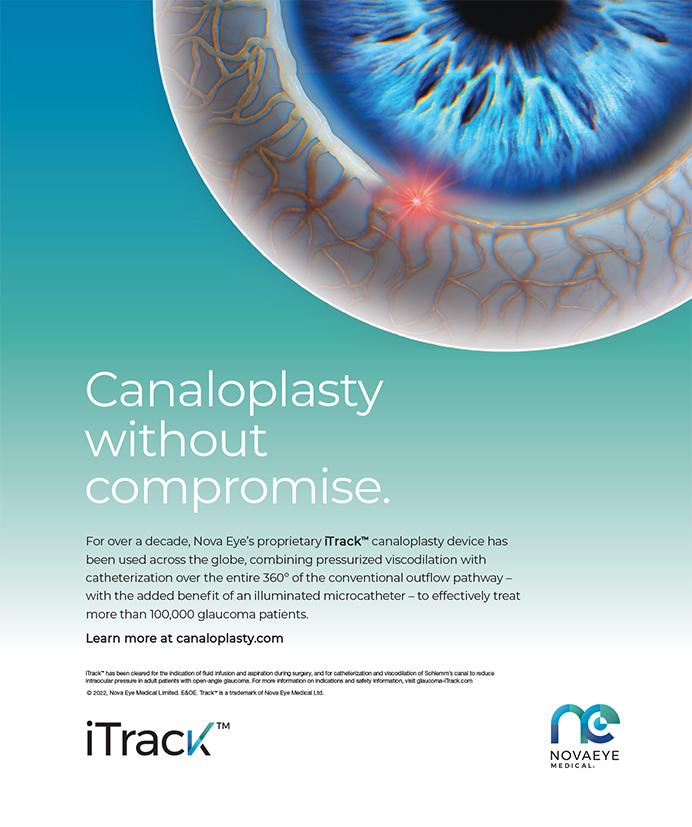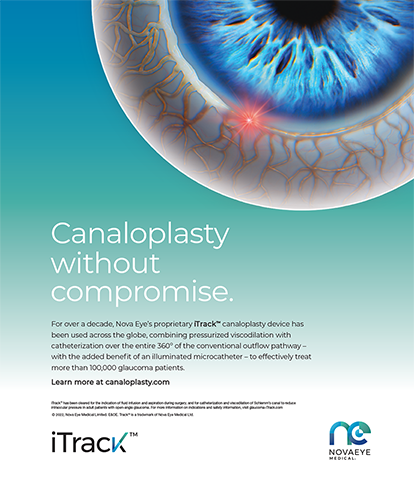CASE PRESENTATION
A 38-year-old man presents for a refractive surgery evaluation. He underwent bilateral LASIK several years ago, possibly in 2001, but he does not recall who the surgeon was. Nor does he have any preoperative information available to share with you. He says his vision was “fine” for a few years but then began to deteriorate in both eyes. Upon further questioning, he states that his father has a diagnosis of keratoconus.
The patient’s current refraction (manifest and cycloplegic) is -1.25 -0.50 X 105 = 20/20 OD and -1.75 D sphere = 20/20- OS. Central corneal thickness by ultrasound pachymetry measures 581 μm OD and 579 μm OS (Figures 1-4). How would you counsel this patient? What type of surgery would you perform, if any?
CARLOS G. ARCE, MD
I would explain to the patient that residual myopia after myopic LASIK surgery may be due to a lack of treatment, myopic progression, or regression due to corneal changes. The lack of preoperative information makes a retreatment difficult. The surgeon can estimate the degree of preoperative myopia and the amount of treatment from the difference between the peripheral (beyond the 7-mm–diameter untouched zone) and central (within the 4-mm–diameter treated zone) average total corneal power by ray tracing.1,2 Axial or tangential curvature maps are less useful because of calculation bias at the periphery. The values of the anterior Q factor or squared eccentricity (E2) provide clues on how oblate the corneal surface became. The closer to zero they are, the smaller the ablation was2 (also C. G. Arce, MD; E. C. Bernilla, MD; and P. Schor, MD; unpublished data, 2011). Finally, the surgeon can use the central posterior curvature to calculate the original anterior central curvature.3
Ophthalmologists do not yet know all of the factors that trigger iatrogenic ectasia, but myopic regression can occur when the cornea weakens over time. During the past 7 years, my colleagues and I have successfully treated a patient with advanced ectasia in both eyes (one eye underwent corneal collagen cross-linking [CXL])4 and more than 20 of 30 cases with little residual postoperative myopia in one or both eyes5 with brimonidine tartrate 0.2%4,5 and/or timolol maleate 0.5% (C. G. Arce, MD, and J. L. Dias, MD, unpublished data, 2010). Based on our experience, I would not perform an enhancement after LASIK or PRK without first conducting a therapeutic trial with topical IOP-lowering medication for a minimum of 3 months.6 At that time, one can evaluate the topographic indices and titrate the topical drops as needed. Although we did not detect a decrease in IOP, my colleagues and I observed a reduction in the spherocylindrical refraction. Eyes with compliant corneas approached a plano refraction and then underwent CXL instead of observation for possible worsening or additional laser ablation that might have further weakened the cornea (C. G. Arce, MD, and J. L. Dias, MD, unpublished data, 2011).
Our first therapeutic trial with topical IOP-lowering medication occurred after we observed corneas that underwent myopic LASIK with reversible changes in refraction, according to the altitude over sea level. Indirect support came in the form of the apparently highest prevalence of keratoconus in Latin American cities with less atmospheric pressure over 2,000 mts of altitude (Cuzco, Quito, Bogotá, Mexico Federal District) compared with cities at sea level in the same country.6 Interestingly, similar findings have been reported in Abha, Saudi Arabia, and other places around the world.7
I should note that it was difficult to explain to some patients why we wished to treat a rare complication that may appear after LASIK or PRK. Compliance may not be achieved. Negative publicity about ectasia is also an issue, and in cases for which I was not the surgeon, I did my best to avoid comment on a colleague. In addition, many surgeons do not understand why my colleagues and I use ocular hypotensive medication in these cases. I have received harsh criticism for this off-label practice when a patient has sought a second or third opinion.
GASTON O. LACAYO III, MD
This case illustrates a growing trend of young patients treated 10 years ago who return for “enhancements” and the importance of careful screening and counseling before retreatment. Given this patient’s positive family history of keratoconus, I would question him about a history of atopy, his propensity for eye rubbing, and whether he likes to sleep with his hands directly over his eyes—all of which are commonly associated with keratoconus. A review of the images obtained with the Pentacam Comprehensive Eye Scanner suggests anterior and posterior corneal elevation in both eyes. The induced myopia and paracentral steepening are of great concern for post-LASIK ectasia from possible underlying keratoconus.
Given the current presentation and lack of previous records, I would not pursue further laser vision correction. Instead, I would recommend the use of glasses or contact lenses and would observe the patient for a period of 6 months to a year, with particular attention to ectatic progression. If his BCVA decreased or there were topographic evidence of corneal steeping, I would recommend CXL (a procedure currently in FDA trials in multiple cities across the United States). I would favor an “epithelium-on” treatment, which early US data suggest halts progression, improves BSCVA in more than 50% of eyes by 3 months postoperatively, and increases patients’ satisfaction compared with “epithelium-off” treatment.8
If CXL produced refractive stability and improved the patient’s BCVA, future surface ablation would be a possibility. European data have shown successful results for the simultaneous and sequential treatment of progressive keratoconus and post-LASIK corneal ectasia with CXL and surface ablation.9
GEORGE O. WARING IV, MD
The most notable Pentacam findings include (1) irregular astigmatism with inferior steepening, (2) a moderately decentered thinnest pachymetric point in the patient’s right eye, and (3) an island of suspicious posterior elevation accentuated by the enhanced reference surface that somewhat corresponds to the thinnest point in the right eye. The pachymetric progression is of greater concern for the patient’s right versus left eye, but this information must be interpreted with caution after LASIK. In addition, the patient has a family history of keratoconus.
After confirming that the patient does not wear contact lenses, I would obtain Placido-based topography and repeat imaging with the Pentacam. I would perform Fourier-domain optical coherence tomography to identify the thickness of the flap and residual stromal bed as well as to identify any signs of irregularity in the flap, possibly resulting from the original surgery. I would discuss with the patient the aforementioned risk factors for the development or exacerbation of ectasia with further refractive surgery and his possible need for CXL and/or a deep anterior lamellar keratoplasty in the future. This discussion would be clearly documented in the chart, and I would ask the patient to sign an additional informed consent if he elected to proceed with surgical correction.
Nonsurgical options for vision correction include rigid gas permeable contact lenses. If the patient understood the risks and was highly motivated for surgical correction now, I would offer advanced surface ablation with mitomycin C in his dominant eye to anticipate future presbyopic changes. If high-quality wavefront maps were obtainable, I would perform a customized treatment. If not and/or if the patient were willing to wait, I would monitor him for refractive stability and, assuming its confirmation, would perform a topography-guided surface ablation once the procedure received approval in the United States. I would exercise extreme care during epithelial removal and watch for possible irregularities in the flap resulting from the original surgery.
Parag Majmudar, MD, would like to thank Penny Asbell, MD, MBA, for supplying this case.
Section Editor Stephen Coleman, MD, is the director of Coleman Vision in Albuquerque, New Mexico. Parag A. Majmudar, MD, is an associate professor, Cornea Service, Rush University Medical Center, Chicago Cornea Consultants, Ltd. Karl G. Stonecipher, MD, is the director of refractive surgery at TLC in Greensboro, North Carolina. Dr. Majmudar may be reached at (847) 882-5900; pamajmudar@chicagocornea.com.
Carlos G. Arce, MD, is in private practice in Campinas and is an associate volunteer ophthalmologist in the Ocular Bioengineering and Refractive Surgery Sectors, Department of Ophthalmology, Federal University of São Paulo in São Paulo, Brazil. He is the medical director and Galilei R&D consultant for Ziemer Ophthalmic Systems AG but acknowledged no financial interest in the drugs he mentioned. Dr. Arce may be reached at +55 19 3258 3344 or +41 79 222 6685; cgarce@terra.com.br.
Gaston O. Lacayo III, MD, is in private practice at the Center for Excellence in Eye Care in Miami, and he is an assistant professor with the Department of Ophthalmology at Rush University Medical Center in Chicago. He acknowledged no financial interest in the product or company he mentioned. Dr. Lacayo may be reached at (305) 598-2020; gaston_lacayo@rush.edu.
George O. Waring IV, MD, is a cornea, cataract, and refractive surgeon with ReVision Advanced Laser Eye Center in Columbus, Ohio. Dr. Waring is also the medical director of the Division of Ophthalmology at St. Joseph’s Translational Research Institute in Atlanta. He is an investigator for and is chairman of the scientific advisory board of Topcon/SOOFT CXL technologies. Dr. Waring may be reached at georgewaringiv@gmail.com.
- Maidana EJ,Alzamora JB,Arce CG,et al.Method to assess the preoperative central corneal power in eyes with myopic refractive surgery.Paper presented at:XXV Pan American Congress of Ophthalmology;March 18-21,2005; Santiago,Chile.
- Arce CG.Galilei:placido topography and anterior segment tomography with double Scheimpflug (in Spanish).In: Castillo Gómez A,ed.Métodos Diagnósticos en Segmento Anterior.Madrid,Spain:Sociedad Española de Cirugía Ocular Implanto-Refractiva (SECOIR);2011:211-236.
- Aramberri J.Corneal power after refractive surgery using available anterior/posterior ratio.Paper presented at:XXIV ESCRS;September 9-13,2006;London,United Kingdom.
- Arce CG,Maidana ES,Campos M,et al.Ectasia regression with ocular topical hypotensors.Case report.Poster presented at:XII Research Days,Federal University of Sao Paulo;December 10-11,2010;Sao Paulo,Brazil.
- Arce CG,Dias JL,Campos MS,Schor P.Modulation of progressive postoperative corneal ectasia.Paper presented at: ASCRS Symposium on Cataract,IOL and Refractive Surgery;April 5,2008;Chicago,IL.
- Arce CG,Trattler W.Keratoconus and keratoectasia.In:Boyd S,Gutierrez AM,McCulley JP,eds.Atlas and Text of Corneal Pathology and Surgery. Panamá City,Panamá:Jaypee-Highlights Medical Publishers;2010:161-225.
- Assiri AA,Yousuf BI,Quantock AJ,Murphy PJ.Incidence and severity of keratoconus in Asir province,Saudi Arabia. Br J Ophthalmol.2005;89:1403-1406.
- Rubinfeld R,Trattler W,Majmudar P,et al.Multicenter evaluation of trans-epithelial versus epithelium-off corneal collagen cross-linking (CXL) for keratoconus and post-LASIK ectasia.Poster presented at:The AAO Annual Meeting; October 24-25,2011;Orlando,FL.
- Kanellopoulos AJ.Comparison of sequential vs same-day simultaneous collagen cross-linking and topographyguided PRK for treatment of keratoconus.J Refract Surg.2009;25(9):S812-S818.


